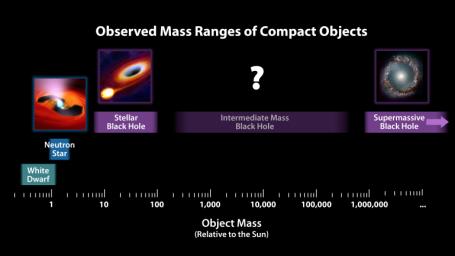This chart illustrates the relative masses of super-dense cosmic objects, ranging from white dwarfs to the supermassive black holes encased in the cores of most galaxies. The first three "dead" stars at left all form when stars more massive than our sun explode; the more massive the star, the more massive the stellar remnant, or compact object, is left behind.
While neutron stars -- which are created from the explosions of stars more than about 10 times the mass of the sun -- are low in mass compared to black holes, they are still quite hefty and incredibly dense. A spoonful of a neutron star would weigh as much as all of the humans on Earth.
Researchers suspect that a class of intermediate-mass black holes exist, with masses up to more than 100,000 times that of our sun, but the mystery remains unsolved.
Supermassive black holes at the hearts of galaxies are formed together with their nascent galaxies out of giant, collapsing clouds of matter. They can weigh up to the equivalent of 10 billion or more suns. Like all of the objects depicted in this chart, supermassive black holes grow in size as they gorge on surrounding matter.
NuSTAR is a Small Explorer mission led by the California Institute of Technology in Pasadena and managed by NASA's Jet Propulsion Laboratory, also in Pasadena, for NASA's Science Mission Directorate in Washington. The spacecraft was built by Orbital Sciences Corporation, Dulles, Virginia. Its instrument was built by a consortium including Caltech; JPL; the University of California, Berkeley; Columbia University, New York; NASA's Goddard Space Flight Center, Greenbelt, Maryland; the Danish Technical University in Denmark; Lawrence Livermore National Laboratory, Livermore, California; ATK Aerospace Systems, Goleta, California, and with support from the Italian Space Agency (ASI) Science Data Center.
NuSTAR's mission operations center is at UC Berkeley, with the ASI providing its equatorial ground station located at Malindi, Kenya. The mission's outreach program is based at Sonoma State University, Rohnert Park, California. NASA's Explorer Program is managed by Goddard. JPL is managed by Caltech for NASA.
For more information, visit http://www.nasa.gov/nustar and http://www.nustar.caltech.edu/.

 Planetary Data System
Planetary Data System












